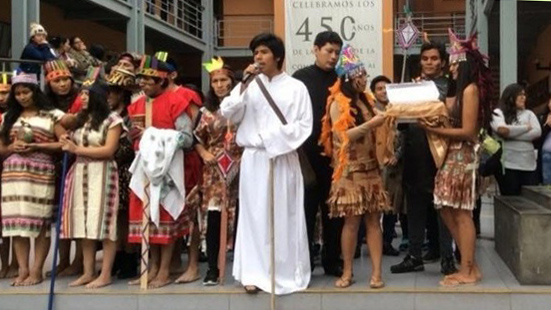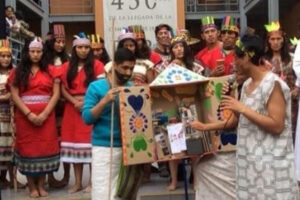
The United Nations was the institution that, in 1994, declared 9 August the International Day of Indigenous Peoples, thereby recognising their rights and their place in our ‘Common Home’ – the world.
This recognition is the result of valuing the contribution these peoples have made, and continue to make, by being guardians of nature and protecting their ancestral traditions. Their worldview has allowed them to keep their culture and customs alive, preserving the wisdom they have acquired over time.
According to the UN, “their territories cover 28% of the planet’s surface and contain 11% of the world’s forests”.[1] However, this population continues to face challenges such as poverty and environmental issues: Indigenous Peoples “make up less than 5 per cent of the world’s population, but account for 15 per cent of the poorest”. (United Nations)
Currently, the Josephites are present in Peru, South América, where there are 55 Indigenous communities, with 93% of the Indigenous Peoples living in the Amazon and 7% in the Andes.[2] The highest concentration of these Indigenous communities is found in the Loreto jungle (18.3%) then in the Andean region of Puno (15.3%). We were present in Loreto until 2021 and we are still present in Puno. In both places, although we have not worked directly with Indigenous populations, our ministry has been primarily related to education because it is the challenge in this part of the country.
On the other hand, faced with this reality, the religious communities, lay people, and priests who carry out their ministry in the Amazon have organised, joining forces and supporting these populations in different ways: assisting on the defence of their rights and the protection of their territories, and through formal and informal educational services. Some institutions I know and have had contact with are the CIMI Team[3], CONFER (Conference of Religious of Perú), CLAR (Conference of Religious in Latin America), REPAM (Network of the Amazon), and the Fe y Alegría Educational Network. As deforestation and the exploitation of Amazonian resources have progressed, various groups of Indigenous Peoples have been forced to leave their territories and have organised themselves into communities. Religious and secular institutions have helped these communities access education in the few schools they have access to and obtain state-funded scholarships so they can pursue higher education.
 At the Jesuit University of Peru where I worked, I had the opportunity to accompany several groups of young people from Asháninka, Awajún, and Wampis communities. The challenges these young people face are diverse: environmental, socio-emotional, and cultural. Added to this is the low educational level these young people arrive with, which poses a challenge for all teachers and the university community. However, the resilience of these young people and the desire to help their communities drive them to strive for their goals. I always remember the days when, upon entering the classroom, students from the Amazon, who had just entered university, would converse in their native language with liveliness and eloquence. I could observe their ease, innocence, and excitement about studying at a university. I didn’t understand a thing they were saying. The only thing I understood was the body language through which they expressed their hopes, dreams, and desires to contribute to their community.
At the Jesuit University of Peru where I worked, I had the opportunity to accompany several groups of young people from Asháninka, Awajún, and Wampis communities. The challenges these young people face are diverse: environmental, socio-emotional, and cultural. Added to this is the low educational level these young people arrive with, which poses a challenge for all teachers and the university community. However, the resilience of these young people and the desire to help their communities drive them to strive for their goals. I always remember the days when, upon entering the classroom, students from the Amazon, who had just entered university, would converse in their native language with liveliness and eloquence. I could observe their ease, innocence, and excitement about studying at a university. I didn’t understand a thing they were saying. The only thing I understood was the body language through which they expressed their hopes, dreams, and desires to contribute to their community.
Finally, it is no coincidence that this date coincides with the month of the Peruvian Saint Rose of Lima. Her feast day is 23 August and her patronage includes Peru, Latin America, Indigenous Peoples of the Americas, among others. She was a lay woman who dedicated her life to serving, in a special way, the disadvantaged and poor of her time. Indigenous populations were the most vulnerable in colonial Peru. This task continues and remains a challenge worldwide.
Sr Jenny Mori León rsj
Footnotes:
[1] United Nations: International Day of the World’s Indigenous Peoples – https://www.un.org/es/observances/indigenous-day
[2] https://www.redesarrollo.pe/blog/comunidades-indigenas-en-el-peru-diversidad-desigualdad-y-pandemia/
[3] https://www.somos-amazonia.org/cimi/
